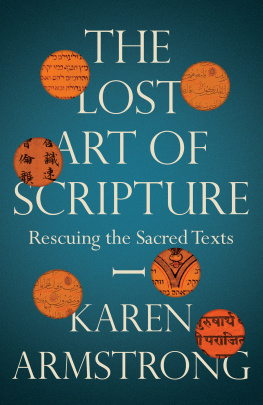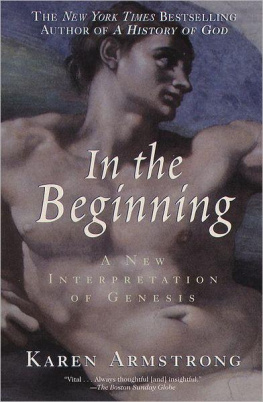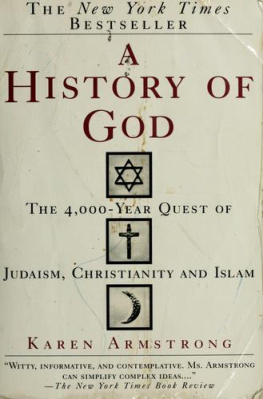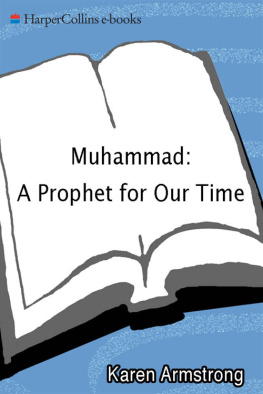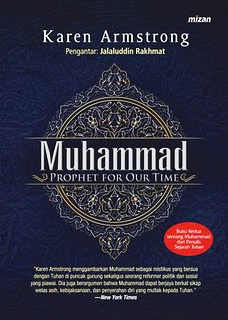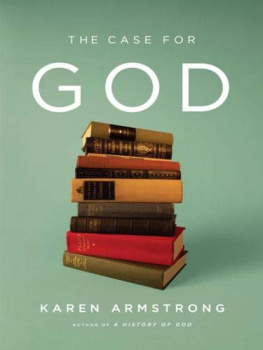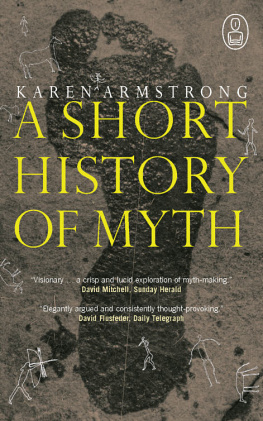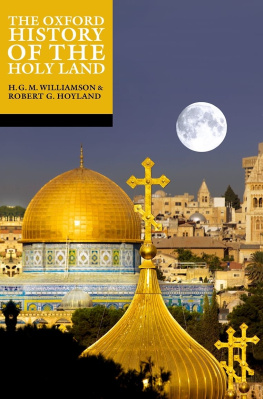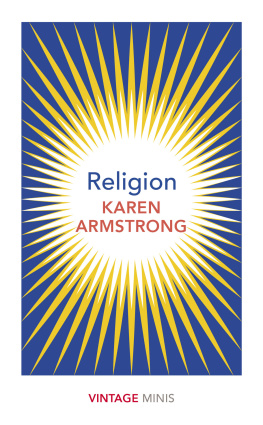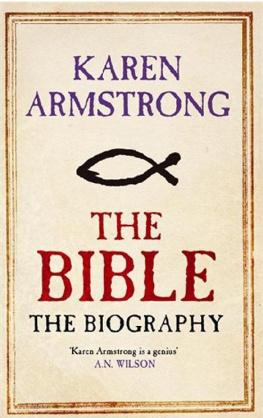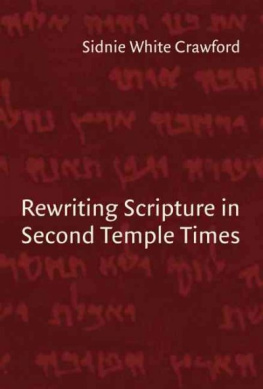

KAREN ARMSTRONG
THE LOST ART OF SCRIPTURE
Rescuing the Sacred Texts

CONTENTS
ABOUT THE AUTHOR
Karen Armstrong is one of the worlds leading commentators on religious affairs. She spent seven years as a Roman Catholic nun, but left her teaching order in 1969 to read English at St Annes College, Oxford. In 1982, she became a full time writer and broadcaster. She is a best-selling author of over 16 books. A passionate campaigner for religious liberty, Armstrong has addressed members of the United States Congress and participated in the World Economic Forum. In 2013 she recieved the British Academys inaugural Nayef Al-Rodhan Prize for improving transcultural understanding.
BY THE SAME AUTHOR
Through the Narrow Gate
A History of God: The 4,000-Year Quest of Judaism, Christianity and Islam
Jerusalem: One City, Three Faiths
Islam: A Short History
Buddha
The Battle for God: Fundamentalism in Judaism, Christianity and Islam
The Spiral Staircase
A Short History of Myth
Muhammad: A Prophet for Our Time
The Great Transformation: The Beginning of Our Religious Traditions
The Bible: The Biography
The Case for God: What Religion Really Means
Twelve Steps to a Compassionate Life
Fields of Blood: Religion and the History of Violence
For Felicity Bryan
Shimshon went down along with his father and mother to Timna
when here, a full-maned roaring lion [coming] to meet him!
YHWHs spirit advanced upon him
and he tore it apart as one tears apart a kid,
without a thing in his hand.
But he did not tell his father and mother what he had done
He returned after a year
he turned aside to see the fallen lion,
and here: a swarm of bees in the lions corpse, and honey!
He broke it off into his hands,
and went along, going and eating.
Then he went back to his father and mother,
and gave some to them, and they ate
But he did not tell them that it was from the lions corpse
that he had broken off the honey.
Judges 14:59 (translated by Everett Fox)
To see a World in a Grain of Sand
And Heaven in a Wild Flower,
Hold Infinity in the palm of your hand
And Eternity in an hour.
William Blake, Auguries of Innocence (1803)
| Conclusion: | If it were not for the Poetic or Prophetic Character the Philosophic & Experimental would soon be the Ratio of all things, and stand still, unable to do other than repeat the same dull round over again. |
| Application: | He who sees the Infinite in all things sees God. He who sees the Ratio only sees himself only. |
| Therefore: | God becomes as we are, that we may be as he is. |
William Blake, There Is No Natural Religion (1788)
INTRODUCTION
A small ivory figurine in the Ulm Museum may be the earliest evidence of human religious activity. Lion Man is 40,000 years old. He has a partly human body and the head of a cave-lion; standing thirty-one centimetres tall, he gazes calmly and attentively at the viewer. Fragments of this statue, carefully stored in an inner chamber, were discovered in the Stadel Cave in southern Germany a few days before the outbreak of the Second World War. We know that groups of Homo sapiens hunted mammoth, reindeer, bison, wild horses and other animals in the region but they do not seem to have lived in the Stadel Cave. Like the Lascaux Caves in southern France, it may have been set aside for communal ritual where people gathered to enact the myths that gave meaning and purpose to their hard and often frightening lives: Lion Mans body is worn, as if he had been repeatedly stroked and caressed while worshippers told his story. He also shows that human beings were now able to think of something that does not exist. The person who crafted him had become fully human, since Homo sapiens is the only animal with the ability to envisage something that is not immediately apparent or has not yet come to be. Lion Man is, therefore, a product of the imagination, which Jean-Paul Sartre defined as the ability to think of what is not. Men and women at this time lived in a reality that transcended the empirical and the factual, and throughout their history human beings would go to great lengths to do this.
The imagination has been the cause of our major achievements in science and technology as well as in art and religion. From a strictly rational perspective, Lion Man could be dismissed as a delusion. But neurologists tell us that in fact we have no direct contact with the world we inhabit. We have only perspectives that come to us through the intricate circuits of our nervous system, so that we all scientists as well as mystics know only representations of reality, not reality itself. We deal with the world as it appears to us, not as it intrinsically is, so some of our interpretations may be more accurate than others. This somewhat disturbing news means that the objective truths on which we rely are inherently illusive. We are surrounded by a reality that transcends or goes beyond our conceptual grasp.
What we regard as truth, therefore, is inescapably bound up with a world that we construct for ourselves. As soon as the first humans learned to manipulate tools, they created works of art to make sense of the terror, wonder and mystery of their existence. From the very beginning, art was inextricably bound up with what we call religion, which is itself an art form. The Lascaux Caves, a cultic site since 17,000 bce , are decorated with numinous paintings of local wildlife, and nearby, in the underground labyrinth of Trois Frres at Arige, there are spectacular engravings of mammoths, bison, wolverines and musk-oxen. Dominating the scene is a massive painted figure, half man, half beast, who fixes his huge, penetrating eyes on visitors as they stumble out of the underground tunnel that provides the only route to this prehistoric temple. Like Lion Man, this hybrid creature transcends anything in our empirical experience but seems to reflect a sense of the underlying unity of animal, human and divine.
Lion Man introduces us to several themes that will be important in our discussion of scripture. He shows that from the very beginning, men and women were deliberately cultivating a perception of existence that differed from the empirical and had an instinctive appetite for a more enhanced state of being, sometimes called the Sacred. In what has been called the perennial philosophy, because it was present in all cultures until the modern period, it was taken for granted that the world was pervaded by and found its explanation in a reality that exceeded the reach of the intellect. This is not surprising, since, as we have seen, we are indeed surrounded by transcendence a reality that we cannot know objectively. In the modern world, we may not cultivate this sense of the transcendent as assiduously as our forebears, but we have all known moments when we are touched deeply within, seem lifted momentarily beyond our everyday selves, and inhabit our humanity more fully than usual in dance, music, poetry, nature, love, sex or sport as well as in what we call religion.
Next page
